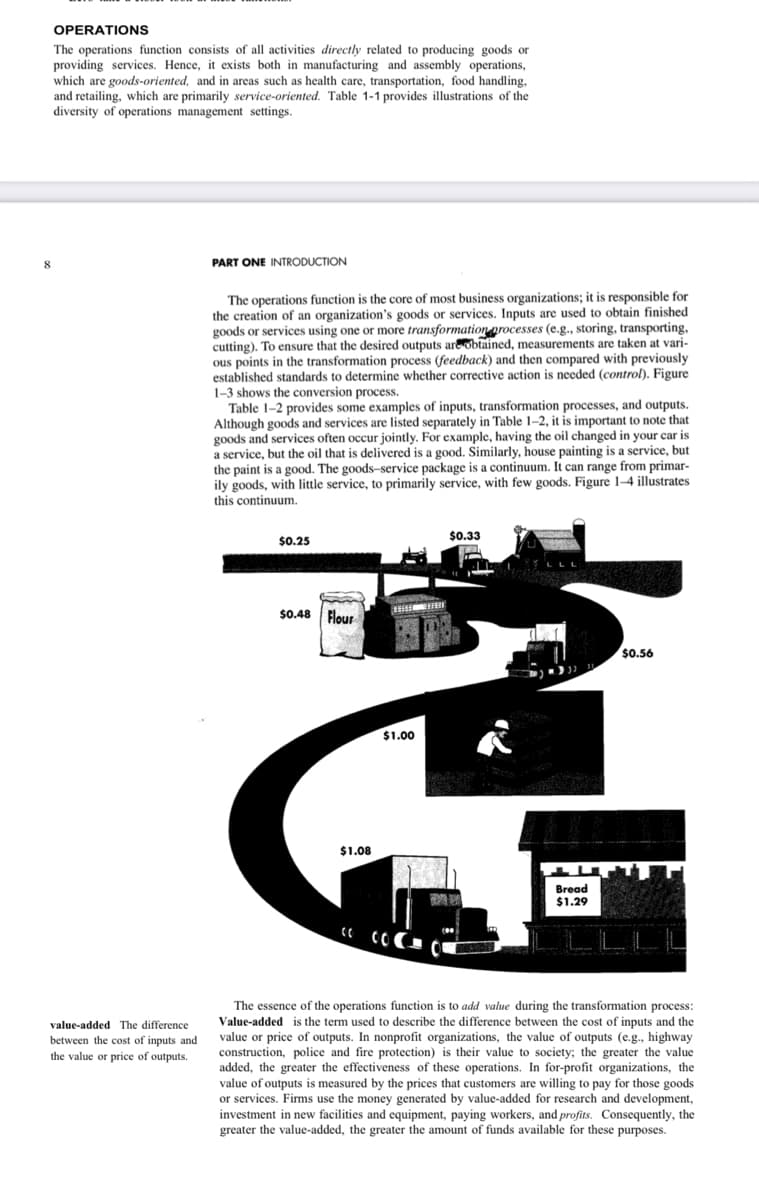Describe the operations function and the nature of the operations manager's job. NOTE: please refer to the given lesson
Describe the operations function and the nature of the operations manager's job. NOTE: please refer to the given lesson
Practical Management Science
6th Edition
ISBN:9781337406659
Author:WINSTON, Wayne L.
Publisher:WINSTON, Wayne L.
Chapter2: Introduction To Spreadsheet Modeling
Section: Chapter Questions
Problem 20P: Julie James is opening a lemonade stand. She believes the fixed cost per week of running the stand...
Related questions
Question
Describe the operations function and the nature of the operations manager's job.
NOTE: please refer to the given lesson

Transcribed Image Text:8
OPERATIONS
The operations function consists of all activities directly related to producing goods or
providing services. Hence, it exists both in manufacturing and assembly operations,
which are goods-oriented, and in areas such as health care, transportation, food handling,
and retailing, which are primarily service-oriented. Table 1-1 provides illustrations of the
diversity of operations management settings.
value-added The difference
between the cost of inputs and
the value or price of outputs.
PART ONE INTRODUCTION
The operations function is the core of most business organizations; it is responsible for
the creation of an organization's goods or services. Inputs are used to obtain finished.
goods or services using one or more transformation processes (e.g., storing, transporting,
cutting). To ensure that the desired outputs are obtained, measurements are taken at vari-
ous points in the transformation process (feedback) and then compared with previously
established standards to determine whether corrective action is needed (control). Figure
1-3 shows the conversion process.
Table 1-2 provides some examples of inputs, transformation processes, and outputs.
Although goods and services are listed separately in Table 1-2, it is important to note that
goods and services often occur jointly. For example, having the oil changed in your car is
a service, but the oil that is delivered is a good. Similarly, house painting is a service, but
the paint is a good. The goods-service package is a continuum. It can range from primar-
ily goods, with little service, to primarily service, with few goods. Figure 1-4 illustrates
this continuum.
$0.33
$0.48 Flour
$0.56
$1.00
萬
110
$1.08
Bread
2024 20
商暴
$1.29
$0.25
The essence of the operations function is to add value during the transformation process:
Value-added is the term used to describe the difference between the cost of inputs and the
value or price of outputs. In nonprofit organizations, the value of outputs (e.g., highway
construction, police and fire protection) is their value to society; the greater the value
were of them
added, the greater the effectiveness of these operations. In for-profit organizations, the
value of outputs is measured by the prices that customers are willing to pay for those goods
or services. Firms use the money generated by value-added for research and development,
investment in new facilities and equipment, paying workers, and profits. Consequently, the
greater the value-added, the greater the amount of funds available for these purposes.
Expert Solution
This question has been solved!
Explore an expertly crafted, step-by-step solution for a thorough understanding of key concepts.
Step by step
Solved in 2 steps

Recommended textbooks for you

Practical Management Science
Operations Management
ISBN:
9781337406659
Author:
WINSTON, Wayne L.
Publisher:
Cengage,

Operations Management
Operations Management
ISBN:
9781259667473
Author:
William J Stevenson
Publisher:
McGraw-Hill Education

Operations and Supply Chain Management (Mcgraw-hi…
Operations Management
ISBN:
9781259666100
Author:
F. Robert Jacobs, Richard B Chase
Publisher:
McGraw-Hill Education

Practical Management Science
Operations Management
ISBN:
9781337406659
Author:
WINSTON, Wayne L.
Publisher:
Cengage,

Operations Management
Operations Management
ISBN:
9781259667473
Author:
William J Stevenson
Publisher:
McGraw-Hill Education

Operations and Supply Chain Management (Mcgraw-hi…
Operations Management
ISBN:
9781259666100
Author:
F. Robert Jacobs, Richard B Chase
Publisher:
McGraw-Hill Education


Purchasing and Supply Chain Management
Operations Management
ISBN:
9781285869681
Author:
Robert M. Monczka, Robert B. Handfield, Larry C. Giunipero, James L. Patterson
Publisher:
Cengage Learning

Production and Operations Analysis, Seventh Editi…
Operations Management
ISBN:
9781478623069
Author:
Steven Nahmias, Tava Lennon Olsen
Publisher:
Waveland Press, Inc.